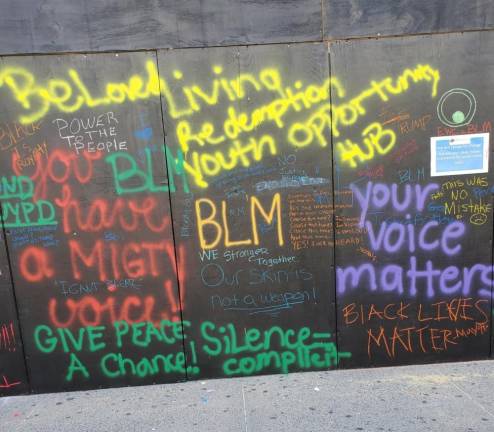Harlem’s Canvases For Change
Businesses take an artistic approach to protesting during a pandemic

New York City continues to inch its way towards a resurgence of life. Well, of sorts, that is. As the city executes phase one of the reopening, there’s the semblance of hope for the return of the normal. But that hope stays buried under the feelings of anguish and rebellion that have emanated from the deaths of Ahmaud Arbery, Breonna Taylor, and George Floyd over the past few weeks. Protestors continue to take to the streets in support of Black Lives Matter and other causes.
In the midst of all this, Harlem’s 125th Street Business Improvement District (BID) has come up with a way for a more creative expression of pent up emotions. On Thursday, June 3, the 125th Street BID initiated the “Harlem Canvas For Change” project, to encourage members of the community, protestors, even people just passing through the neighborhood, to use art and painting to showcase their ideas, emotions and messages. The canvases for the artwork would be the plywood boards on all the storefronts and businesses that are closed because of the pandemic.
The project, launched under BID president Barbara Askins, initially came about as storefronts were boarded up to prevent break-ins. “Most of downtown was already boarded up, after trying to stay open as long as we could,” says Askins. “And then two of the businesses were broken into. One was a Blink Fitness, the other was an H&M.” As the community dove into protest mode, the need arose for the businesses to fortify their storefronts with plywood boards to prevent further looting.
“So one of my property owners called me himself and said he did not like the look of 125th Street all boarded-up and that they were going to paint that wall of wood all black.” He suggested that they use some artwork or wording on the black wood so the businesses could say something to the community. But the thought of painting them all black gave Askins a different idea.
“I suggested to him, why don’t you just paint the wall black and just give it to the community and let them say what they have to say?” she says. “Nobody’s really interested at this particular time about what the businesses are saying. That’s just not the space we’re in. Let’s hear what the people have to say.” And after a day of putting up the wooden boards and painting them all black, the BID issued a call-out to everyone and anyone, artists, members of the community, politicians, celebrities, to use the canvas to express themselves.
The BID partnered up with one of the local businesses in the area, Blick Art Supplies, to provide mediums to their artists. “And to make it happen, they gave us paints for about 150 people,” Askins explains. “So we put our ambassadors out there on the street with the paint. And all you have to do is just show up and write or paint or draw.”
Public Policy Statement
The first two available walls, wrapping around the AMC/Magic Johnson Theatres (#PrayForAMC), filled up in a day, with a third wall filling up on the next. Response, according to Askins, has been immediate and immense. “125th is a major transportation hub,” she says. “So we’ve got people coming from everywhere, coming up to us and going ‘can I?’ It’s not just local.” Many of the protestors have also contributed to the walls, filling it up with phrases like “BLM,” “Black Girl Magic,” and “You have a mighty voice!” The hashtag #harlemcanvasforchange already has more than 30 posts on Instagram.
“Everybody is upset about what is happening, and they should be,” Askins adds. “So we’re giving them a place to express, and not just express, but also make recommendations for what they think needs to be done as it relates to social justice.” The BID is working with Columbia University’s School of International Public Policy in order to take the suggestions that they’re getting to craft and advocate for a public policy statement.
The BID intends to continue with the project for around 6-8 weeks as they slowly reconfigure the working of businesses in compliance with social distancing norms. At the same time, they’re also keeping in mind the protests taking place in the area. “All of those things are making business owners too slow to just come back full force, which is why we’re giving this some time,” Askins says.
Art has been part of Harlem and 125th Street’s history for a while now, with store shutters, walls, even pillars decorated with all sorts of colorful work. And “Harlem Canvas For Change” is well on track to serve as a time capsule and memory of a particularly notable period in the history of New York City and the world at large.
“Everybody is upset about what is happening, and they should be. So we’re giving them a place to express, and ... make recommendations for what they think needs to be done as it relates to social justice.” Barbara Askins, President of 125th Street BID